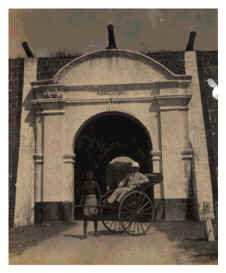

Dr. Wilbur A. Sawyer in Fort, Jaffna 1924
(Date on facade ANNO 1640?)
Wilbur Sawyer started college at the University of California, Berkeley. He transferred to Harvard University in his second year, and got his AB there in 1902. He attended Harvard Medical School, received his MD in 1906.
In 1908, Sawyer returned to California to take a position as Medical Examiner in the University of California's infirmary. In 1915 he became secretary and executive officer of the California State Board of Health, and moved his family to Sacramento.
In June 1919 he went to work for the Rockefeller Foundation International Health Division; his first assignment was to set up hookworm control projects in Australia. For the next five years he directed the hookworm campaign there, and served as assistant director for the East, helping Dr. Victor Heiser supervise projects in Ceylon, Siam, and Indonesia.
In late 1926, Sawyer was sent to Lagos, Nigeria, as acting director of the RF West Africa Yellow Fever Commission, and joined the small group of investigators researching the disease there. In 1928, the RF established a small yellow fever laboratory at the Rockefeller Institute, and appointed Sawyer its director. At the Yellow Fever Laboratory, Sawyer and his colleagues built on the important work that had been done by the West Africa Yellow Fever Commission.
They developed techniques to preserve the virus for long periods, compared virus samples from Brazil and West Africa and proved them to be the same organism, and in 1931 developed and refined the first effective yellow fever vaccine. Sawyer also helped to develop a test for yellow fever immunity using mice (the mouse protection test) and used this to carry out an international survey of yellow fever exposure and to map where the disease had occurred in recent generations.In 1937, Dr. Max Theiler, working at the Yellow Fever Laboratory, developed a safer attenuated yellow fever virus, the 17D strain, and methods for producing the vaccine in large quantities, thus making mass vaccination programs feasible. Dr. Theiler won the Nobel Prize for medicine in 1951. Doctors at that time thought Sawyer should have shared the Nobel Prize with Theiler.
Source: http://profiles.nlm.nih.gov/LW/Views/Exhibit/narrative/biographical.html